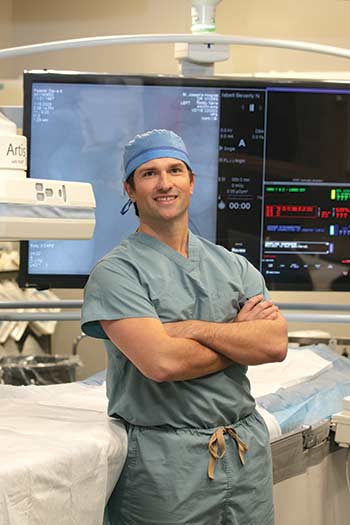A Benign Alternative For Men
An interventional radiology procedure can help certain patients with a common prostate problem
For millions of men of a certain age, leisure time may undergo some small but notable changes. When buying tickets for a concert or sporting event, you used to get seats closest to the action. Now you make sure your seats are closest to the bathroom.
When planning a road trip, you used to pick the quickest or most fuel-efficient route. Now you need the road with the most available rest stops.

The cause is benign prostatic hyperplasia, or BPH—also known as an enlarged prostate gland. It’s nothing to be embarrassed about, and luckily, there are many treatment options available. Mild or moderate cases can be managed with medication. Surgery is available for more severe cases.
For those who are not candidates for surgery, there is another alternative—a prostatic artery embolization, or PAE. In a PAE, an interventional radiologist uses imaging technology to deliver tiny beads to the prostate gland’s blood supply, which will then cause it to shrink. This is an elective outpatient procedure with moderate sedation and no anesthesia. The PAE is currently only offered in this region at Candler Hospital by interventional radiologist Robert “Hunter” Dunlap, MD.
A Quality of Life Issue
Dr. Dunlap says that many of his benign prostatic hyperplasia patients are referred to treatment by their wives.
“These women are tired of having their husbands get up four or five times every night,” he says. “On vacations or outings, they see their loved ones’ lives being governed by their access to the bathroom. Many of these men may already be on medications. They really can’t help it.”
The prostate gland is located beneath the bladder, and it continues to grow for most of a man’s life. If it becomes too enlarged through the years, it can cause problems with urination.
Common symptoms of benign prostatic hyperplasia are:
- More frequent urination, especially at night
- Urgency to urinate
- Feeling unable to empty the bladder
- Dribbling or leaking of urine
“These may seem like little things, but they can affect the quality of your life,” Dr. Dunlap says.
Certain medications can help mild cases by either relaxing bladder muscles and prostate muscle fibers or by preventing hormonal changes that can lead to this condition. In some cases, the drug therapies may be combined.
If your symptoms are severe or unresponsive to medication, you may need surgery. A urologist can perform a transurethral resection of the prostate, or TURP. With a TURP, the doctor surgically removes part of the prostate. The relief of symptoms happens very quickly after the surgery.
“The TURP is the gold standard in the treatment of benign prostatic hyperplasia,” Dr. Dunlap says. “It’s an excellent procedure. But not everyone is an appropriate candidate for surgery. Older men may be on multiple medications or on blood thinners that they must take continuously. Or they may have co-morbidities such as heart disease or diabetes that can affect their ability to tolerate surgery. The prostatic artery embolization is not intended to replace a TURP; it is there as an alternative for patients who can’t undergo one.”
Cutting The Supply
As an interventional radiologist, Dr. Dunlap uses imaging technology such as X-rays, CT scans, ultrasounds and sometimes MRI scans to complete minimally-invasive procedures. He is board-certified in both diagnostic radiology and interventional radiology.
During a PAE, Dr. Dunlap inserts a microcatheter through a tiny needle poke into the wrist or groin. Guided by imaging technology, he will reach the arteries on each side of the prostate and deliver tiny beads of resin called microspheres through the catheter into the blood vessels.
After the procedure, the patient goes home the same day and can expect a quick recovery. Unlike with a TURP, symptom relief is not instantaneous. But the prostate gland, having had its blood supply cut off by the microspheres, will begin to shrink and the symptoms caused by its enlargement will start to improve.
“It’s extremely gratifying to see how happy these men are when I see them for follow-ups,” Dr. Dunlap says. “Some patients have told me this procedure changed their life.”
An Important Discussion
Men with benign prostatic hyperplasia may wonder if it is a sign of prostate cancer. Dr. Dunlap says the two conditions are separate entities.
“Prostate cancer does not typically cause the lower urinary tract symptoms that are caused by BPH,” he says. “But it is possible to have prostate cancer while also having BPH. So it is still important for men to discuss the risk factors of prostate cancer with their urologist and to let them know about any symptoms they may be experiencing.”
A discussion of symptoms shouldn’t be hampered by embarrassment, either. They are very common in the elderly male population—more than 70 percent of men over the age of 70 will develop benign prostatic hyperplasia. Many of these patients won’t need surgery, but some who do need it may find themselves unable to elect it. That’s why Dr. Dunlap is excited to offer the PAE as another option.
“There are a number of tools to choose from in the treatment of BPH,” he says. “And that is what the PAE is—another highly effective tool in the toolkit.”